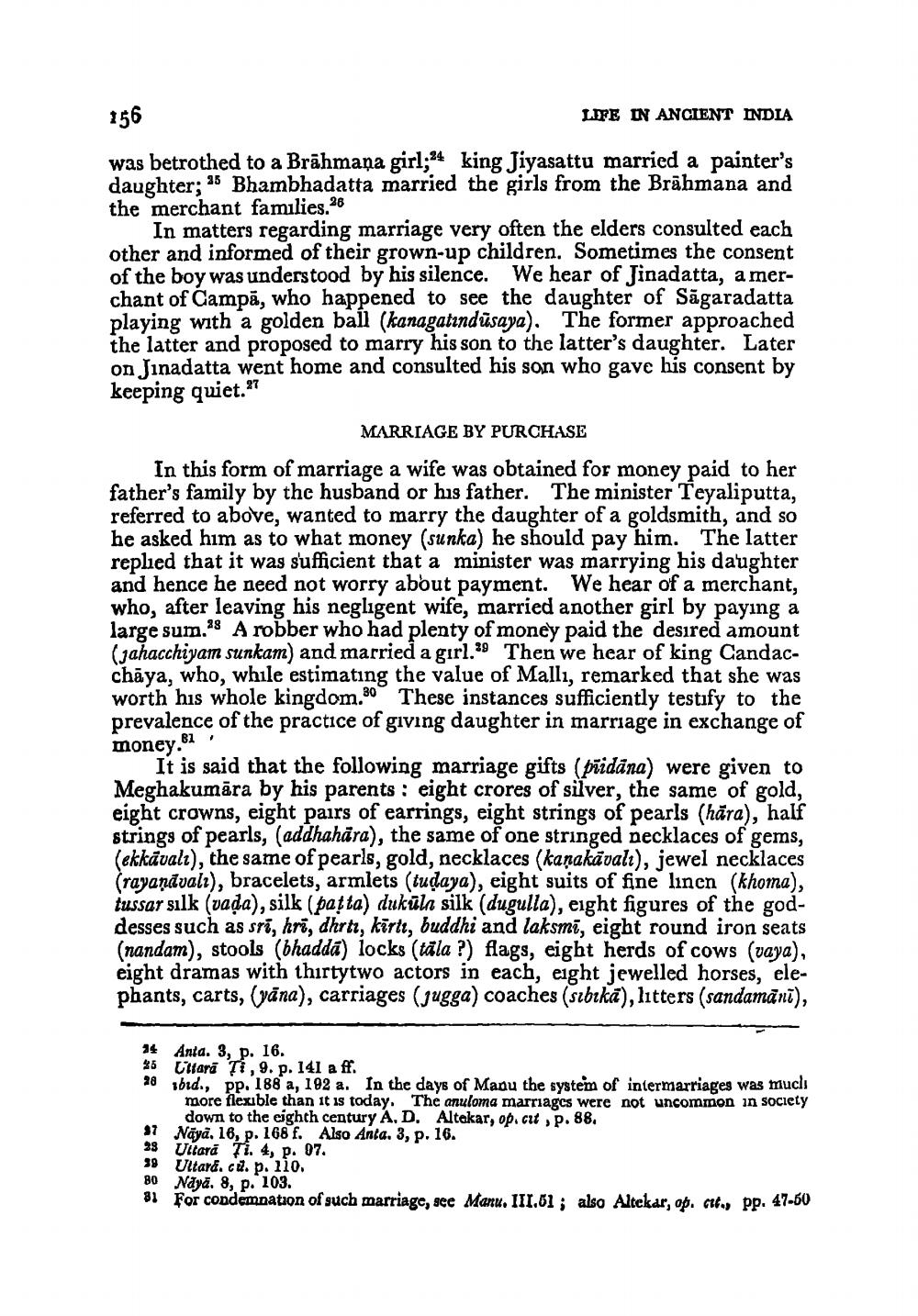________________
156
LIFE IN ANCIENT INDIA
was betrothed to a Brāhmaṇa girl,24 king Jiyasattu married a painter's daughter; *5 Bhambhadatta married the girls from the Brāhmana and the merchant families.26
In matters regarding marriage very often the elders consulted each other and informed of their grown-up children. Sometimes the consent of the boy was understood by his silence. We hear of Jinadatta, a merchant of Campā, who happened to see the daughter of Sāgaradatta playing with a golden ball (kanagatindūsaya). The former approached the latter and proposed to marry his son to the latter's daughter. Later on Jinadatta went home and consulted his son who gave his consent by keeping quiet.27
MARRIAGE BY PURCHASE
In this form of marriage a wife was obtained for money paid to her father's family by the husband or his father. The minister Teyaliputta, referred to above, wanted to marry the daughter of a goldsmith, and so he asked him as to what money (sunka) he should pay him. The latter replied that it was sufficient that a minister was marrying his daughter and hence he need not worry about payment. We hear of a merchant, who, after leaving his negligent wife, married another girl by paying a large sum." A robber who had plenty of money paid the desired amount (Tahacchiyam sunkam) and married a girl.39 Then we hear of king Candacchāya, who, while estimating the value of Mallı, remarked that she was worth his whole kingdom. These instances sufficiently testify to the prevalence of the practice of giving daughter in marriage in exchange of money. 82'
It is said that the following marriage gifts (põidāna) were given to Meghakumāra by his parents : eight crores of silver, the same of gold, eight crowns, eight pairs of earrings, eight strings of pearls (hāra), half strings of pearls, (addhahāra), the same of one stringed necklaces of gems, (ekkävalt), the same of pearls, gold, necklaces (kanakävalt), jewel necklaces (rayanavalı), bracelets, armlets (tudaya), eight suits of fine linen (khoma), tussar silk (vada), silk (patta) duküla silk (dugulla), eight figures of the goddesses such as sri, hrë, dhrtı, kartı, buddhi and laksmi, eight round iron seats (nandam), stools (bhaddā) locks (tāla ?) flags, eight herds of cows (vaya), eight dramas with thirtytwo actors in each, eight jewelled horses, elephants, carts, (yāna), carriages (Jugga) coaches (sıbıkā), litters (sandamāni),
14 Anta. 3, p. 16. 25 Chiara Ti, 9. p. 141 a ff. 28 sbd., pp. 188 a, 192 a. In the days of Manu the system of intermarriages was much
more flexible than it is today. The anuloma marriages were not uncommon in society down to the eighth century AD. Altekar, op. cit, p. 88. Nāyā. 16, p. 168 f. Also Anta. 3, p. 16.
Ultará Ti. 4, p. 07. 39 Ultard. cu. p. 110. 80 Naya. 8, p. 103. 81 For condemnation of such marriage, ace Manu. III.61 ; also Altekar, op. cit., pp. 47-50
38




